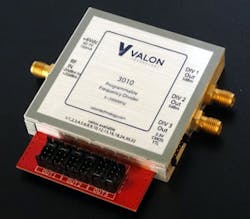Deciding Between Mixers and Multipliers/Dividers
This file type includes high-resolution graphics and schematics when applicable.
Many applications translate frequencies higher or lower in various ways, such as via frequency mixers, frequency multipliers, and frequency dividers. These components take different approaches to transform the frequencies of signals and their modulation content from their inputs to their outputs, but are they interchangeable? When does it make more sense to use a mixer rather than a multiplier or divider?
The main functional difference between the components involves how frequency conversion is achieved: A frequency mixer requires a second input signal, adding and subtracting the two signals to achieve a desired result. On the other hand, a frequency multiplier or divider works with the first input signal alone, extracting the final result from harmonic or subharmonic signal components.
Frequency mixers and multipliers/dividers both rely on the nonlinear behavior of semiconductors, such as diodes and transistors, to translate frequencies from input to output ports. Schottky diodes and GaAs field-effect transistors (FETs) have been long-time choices for RF/microwave mixers. Meanwhile, newer mixers take advantage of monolithic-microwave-integrated-circuit (MMIC) technology to include supporting circuits, such as filters and amplifiers, in compact circuits that fit into surface-mount-technology (SMT) or drop-in packages.
Frequency mixers are three-port circuits that can upconvert input signals to higher frequencies and downconvert input signals to lower frequencies, depending on how the signals are fed to the ports. The three ports in a conventional mixer are the radio-frequency (RF), local-oscillator (LO), and intermediate-frequency (IF) ports; the traditional component symbol for a frequency mixer is a circle with “x” inside. The input signal mixes with the LO signal to achieve the sum (f1 + f2) or difference (f1 – f2) of the two signals.
When the incoming signal is fed to the RF port, a downconverted, lower-frequency signal appears at the IF port. When the incoming signal is applied to the IF port, an upconverted, higher-frequency signal is available at the RF port. Receivers typically employ downconversion, while transmitters require upconversion.
Frequency translation in a mixer can be defined in two ways. In single-sideband conversion, only the sum or difference of the two input signals is available at the mixer output port (and the unwanted signal product suppressed within the mixer). For double-sideband conversion, both the sum and the difference of the two input signals are available at the output and the user filters out the unneeded signal product.
Multiplying and Dividing
Translation to higher frequencies can also be achieved by means of frequency multipliers, as with translation to lower frequency using frequency dividers. In a frequency multiplier, the output signal’s frequency is an integer multiple of the input signal’s frequency: fout = nfin. Output power drops with higher values of n, but high-frequency multiplication is possible by cascading multipliers together. Schottky-barrier or varactor diodes are often the nonlinear semiconductors of choice for frequency multipliers or dividers, with PIN or step-recovery diodes used when the need arises for higher-order multiplication.
1. Frequency-translation components such as this surface-mount frequency multiplier achieve miniaturization through integration. (Courtesy of Mini-Circuits)
Ideally, multiplication would occur with no degradation in the output signal’s spectral purity. In reality, noise occurs with any frequency-translation process, including with multipliers and dividers. A frequency multiplier will increase the phase noise of the source because it is a phase/frequency multiplier, and it will multiply the phase deviations as well as the input signal’s frequency. Similarly, a frequency divider, often comprised of semiconductor prescalers, will contribute additive phase noise to its lower-frequency, divided outputs.
A frequency multiplier will cause a change in the carrier-to-noise ratio (CNR) of an input signal, or ΔCNR, according to the relationship ΔCNR = 20log n, where n is the multiplication factor. As a result, a doubler (n = 2) will cause a degradation of 6 dB in an input signal’s CNR, a quadrupler (n = 4) will raise the noise level by 12 dB, and so forth. However, when multiplying signals from a low-noise source, such as a 10-MHz reference oscillator with low phase noise, it is possible to achieve RF/microwave signals with low phase noise even when using high multiplication factors.
Sizing Up Specifications
Frequency mixers, multipliers, and dividers are characterized by somewhat different parameters, although they can be compared in terms of frequency-conversion loss/gain or conversion efficiency across their applicable bandwidths. The bandwidths of the different components are usually designed according to the requirements of a particular communications or radar system, with models available for narrow, moderate, and wide bandwidths as needed.
Conversion loss (or conversion gain in an active mixer) is a key performance parameter for RF/microwave mixers, with isolation between ports and the 1-dB compression point being important performance details. The conversion loss of a frequency mixer, in general, is considerably less than that of a frequency multiplier or divider. However, the mixer will also require an LO for a particular frequency range and output-power level, and some of the LO’s energy will be lost as part of the frequency-translation process.
When specifying a mixer for a required downconversion or upconversion frequency range, the LO’s performance is as important as that of the mixer circuitry. LO characteristics like phase noise, spurious content, and harmonic content will contribute to the content of the upconverted or downconverted signal, so the choice of LO must be made according to final signal performance requirements.
Some frequency mixers, such as the SIM mixers from Mini-Circuits, are designed for broadband frequency coverage (a total frequency range of 100 kHz to 20 GHz) while maintaining low conversion loss and high port-to-port isolation, even with flexible LO requirements. These mixers, based on low-temperature-cofired-ceramic (LTCC) substrates for commercial, industrial, and military applications, are available with LOs at different power levels: +7, +10, +13, and +17 dBm (often referred to as Level 7, Level 10, and so on). The diversity of models simplifies the task of specifying a mixer for an application, since broadband models can be used for multiple applications
Modern frequency mixers and multipliers benefit from the miniaturization possible with integrated-circuit (IC) processes and SMT packaging (Fig. 1). The usual tradeoff for miniature size is power-handling capability. But, following the trend of increased circuit density in system designs, the small sizes of these components allow for additional circuit functionality in limited space.
For example, GaAs heterojunction-bipolar-transistor (HBT) semiconductor technology is the basis for Mini-Circuits’ CY2-143+ wideband frequency doubler, which comes in a MCLP housing measuring just 4 × 4 × 1 mm. The multiplier provides outputs from 4 to 14 GHz when fed input signals from 2 to 7 GHz. It works with input signal levels from +12 to +18 dBm, and yields output levels to about +6 dBm as a result of 12-dB typical conversion loss across the frequency range. This compact multiplier exhibits good suppression of spurious and fundamental-frequency signals, thus simplifying requirements for additional filtering at the system level.
In applications where frequency translation must be programmable or performed according to a certain protocol, signal and control interfaces may require that a frequency multiplier or divider be housed in a somewhat larger package. As a sophisticated example, the model 3010 programmable frequency divider from Valon Technology handles inputs from 5 to 2000 MHz at RF power levels from –20 to +20 dBm. It also provides multiple 50-⦠coaxial RF and +3.3-V CMOS/TTL-compatible lower-frequency outputs as might be needed for laboratory or test applications.
The 3010 employs a cascade of internal dividers to achieve its broad bandwidth. It allows operators to select from 16 division ratios spanning 1 to 32 by means of hardware jumpers. In exchange for the larger size and power consumption (about 150 mA from +4 to +7 V dc) compared to miniature components, this frequency divider (Fig. 2) provides a wide input dynamic range (typically –20 to +13 dBm) and flexible programmability.




